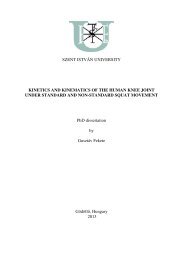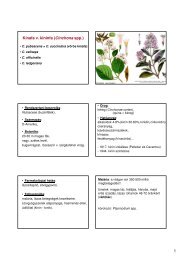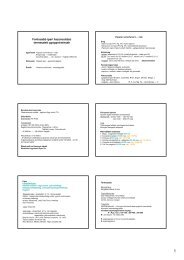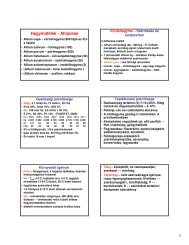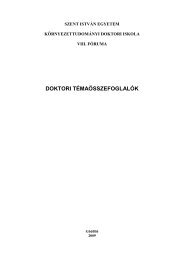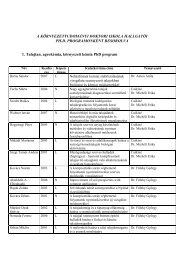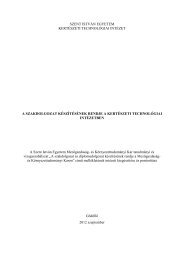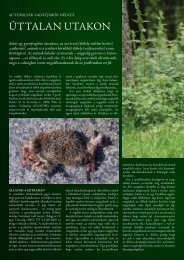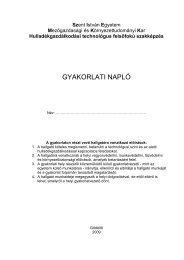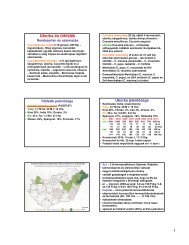Effect of grafting on the tomato's yield, quality - Akademiai.com
Effect of grafting on the tomato's yield, quality - Akademiai.com
Effect of grafting on the tomato's yield, quality - Akademiai.com
You also want an ePaper? Increase the reach of your titles
YUMPU automatically turns print PDFs into web optimized ePapers that Google loves.
Acta Alimentaria, Vol. 34 (4), pp. 453–462 (2005)<br />
EFFECT OF GRAFTING ON THE TOMATO’S YIELD, QUALITY<br />
AND MAIN FRUIT COMPONENTS IN SPRING FORCING<br />
Á. POGONYI a , Z. PÉK a , L. HELYES a and A. LUGASI b *<br />
a Department <str<strong>on</strong>g>of</str<strong>on</strong>g> Horticulture and Technology, Szent István University,<br />
H-2103 Gödöll , Páter K. út 1. Hungary<br />
b Nati<strong>on</strong>al Institute for Food Safety and Nutriti<strong>on</strong>, H-1097 Budapest, Gyáli út 3/a. Hungary<br />
(Received: 9 December 2004; accepted: 31 August 2005)<br />
Soil-born diseases <str<strong>on</strong>g>of</str<strong>on</strong>g>ten cause problems in vegetable forcing; this is because growers use greenhouses<br />
for <strong>the</strong> l<strong>on</strong>gest time possible. During <strong>the</strong> years several soluti<strong>on</strong>s have been found to displace chemical<br />
c<strong>on</strong>trol. Grafting is a possible chemical free soluti<strong>on</strong> that shows several changes in plants thanks to <strong>the</strong><br />
vigorous rootstock. In this study we examined <strong>the</strong> effect <str<strong>on</strong>g>of</str<strong>on</strong>g> <str<strong>on</strong>g>grafting</str<strong>on</strong>g> <strong>on</strong> <strong>the</strong> <strong>yield</strong> and fruit characteristics<br />
in tomato cultivar. Lemance F 1 was used as sci<strong>on</strong> and Beaufort as rootstock. Earliness, total <strong>yield</strong>, fruit<br />
weight and number <str<strong>on</strong>g>of</str<strong>on</strong>g> each graft <strong>com</strong>binati<strong>on</strong> were recorded. Moreover, <strong>the</strong> main fruit <strong>com</strong>p<strong>on</strong>ents<br />
such as Brix°, carbohydrate, acid and <strong>the</strong> carbohydrate/acid ratio were analysed. We harvested more<br />
<strong>yield</strong> from <strong>the</strong> grafted plants. The increase <str<strong>on</strong>g>of</str<strong>on</strong>g> <strong>yield</strong> was mainly caused by higher average fruit weight.<br />
Brix° and carbohydrate c<strong>on</strong>tent were lower in <strong>the</strong> fruits <strong>on</strong> grafted plants than <strong>on</strong> ungrafted <strong>on</strong>es but<br />
<strong>the</strong>re was no significant difference in acid c<strong>on</strong>tent.<br />
Keywords: acid, Brix°, carbohydrate, <str<strong>on</strong>g>grafting</str<strong>on</strong>g>, <strong>quality</strong>, tomato<br />
Use <str<strong>on</strong>g>of</str<strong>on</strong>g> grafted seedlings has be<strong>com</strong>e a widespread practise in many parts <str<strong>on</strong>g>of</str<strong>on</strong>g> <strong>the</strong> world.<br />
One <str<strong>on</strong>g>of</str<strong>on</strong>g> <strong>the</strong> advantages <str<strong>on</strong>g>of</str<strong>on</strong>g> using grafted plants is <strong>the</strong> resistance or tolerance to <strong>the</strong> soilborn<br />
diseases (corky root, fusarium wilt, verticillum wilt, bacterial wilt) and nematodes,<br />
which cause most <str<strong>on</strong>g>of</str<strong>on</strong>g> <strong>the</strong> damages to c<strong>on</strong>tinuous cropping in greenhouses (ODA, 1999;<br />
LEE & ODA, 2003). This was <strong>the</strong> early purpose <str<strong>on</strong>g>of</str<strong>on</strong>g> using grafted seedlings, but <strong>the</strong>re are<br />
several o<strong>the</strong>r reas<strong>on</strong>s <str<strong>on</strong>g>of</str<strong>on</strong>g> <str<strong>on</strong>g>grafting</str<strong>on</strong>g> (LEE, 1994). Due to <strong>the</strong> utilizati<strong>on</strong> <str<strong>on</strong>g>of</str<strong>on</strong>g> vigorous root<br />
system <str<strong>on</strong>g>of</str<strong>on</strong>g> <strong>the</strong> rootstocks, grafted plants usually show increased uptake <str<strong>on</strong>g>of</str<strong>on</strong>g> water and<br />
minerals <strong>com</strong>pared to self-rooted plants. There are several o<strong>the</strong>r advantages <str<strong>on</strong>g>of</str<strong>on</strong>g> <str<strong>on</strong>g>grafting</str<strong>on</strong>g><br />
such as low and high temperature tolerance, salt tolerance, extended harvest period,<br />
earliness and increase <str<strong>on</strong>g>of</str<strong>on</strong>g> <strong>yield</strong> (LEE & ODA, 2003). Tomato is a major vegetable where<br />
<str<strong>on</strong>g>grafting</str<strong>on</strong>g> is important worldwide, although <str<strong>on</strong>g>grafting</str<strong>on</strong>g> is also <str<strong>on</strong>g>of</str<strong>on</strong>g>ten used in case <str<strong>on</strong>g>of</str<strong>on</strong>g><br />
watermel<strong>on</strong>, cucumber, mel<strong>on</strong>, eggplant and capsicum pepper (LEE, 2003).<br />
Tomato c<strong>on</strong>tains about 93–96% water. The total soluble solids range from 4% to<br />
9% (ADAMS, 1986). The c<strong>on</strong>tent <str<strong>on</strong>g>of</str<strong>on</strong>g> total soluble solids is inversely related to fruit<br />
<strong>yield</strong> (STEVENS & RUDICH, 1978). Sugars, mainly glucose and fructose, account for<br />
about half <str<strong>on</strong>g>of</str<strong>on</strong>g> <strong>the</strong> dry matter or 65% <str<strong>on</strong>g>of</str<strong>on</strong>g> <strong>the</strong> soluble solids <str<strong>on</strong>g>of</str<strong>on</strong>g> a ripe tomato fruit.<br />
* To whom corresp<strong>on</strong>dence should be addressed.<br />
Ph<strong>on</strong>e: +36-1-476-6461; fax: +36-1-215-5369, e-mail: lugasi@oeti.antsz.hu<br />
0139-3006/$ 20.00 2005 Akadémiai Kiadó, Budapest
454 POGONYI et al.: EFFECT OF GRAFTING ON TOMATO QUALITY<br />
The sugar c<strong>on</strong>tent ranges from 1.7 to 4.0% <str<strong>on</strong>g>of</str<strong>on</strong>g> fruit fresh weight. The organic acids in a<br />
tomato fruit c<strong>on</strong>sist mainly <str<strong>on</strong>g>of</str<strong>on</strong>g> citric and malic acid. The acid c<strong>on</strong>tent ranges from 0.3–<br />
0.6% (HELYES, 1999).<br />
Sugars, acids and <strong>the</strong>ir interacti<strong>on</strong>s are important in relati<strong>on</strong> to sweetness, sourness,<br />
and flavour intensity in tomatoes. Much sugar and relatively high c<strong>on</strong>centrati<strong>on</strong> <str<strong>on</strong>g>of</str<strong>on</strong>g> acids<br />
are required for <strong>the</strong> best flavour. High c<strong>on</strong>centrati<strong>on</strong> <str<strong>on</strong>g>of</str<strong>on</strong>g> acids and low sugar c<strong>on</strong>tent will<br />
produce a tart tomato, while high sugar c<strong>on</strong>tent and low c<strong>on</strong>centrati<strong>on</strong> <str<strong>on</strong>g>of</str<strong>on</strong>g> acids will<br />
result in a bland taste. When both sugar and acid c<strong>on</strong>tents are low, <strong>the</strong> result is a<br />
tasteless, insipid tomato. It is supposed <strong>the</strong> best if <strong>the</strong> ratio <str<strong>on</strong>g>of</str<strong>on</strong>g> sugar to acid ranges from<br />
9 to 10 (HELYES, 1999).<br />
Numerous rootstocks were developed, which have quite different characteristics<br />
and resistance (LEE, 1994). For example, eggplants were <strong>com</strong>m<strong>on</strong>ly used as rootstocks<br />
for tomato in earlier years (LEE & ODA, 2003).<br />
ODA and co-workers (1996) examined <strong>the</strong> effect <str<strong>on</strong>g>of</str<strong>on</strong>g> scarlet eggplant rootstock <strong>on</strong><br />
growth, <strong>yield</strong> and sugar c<strong>on</strong>tent <str<strong>on</strong>g>of</str<strong>on</strong>g> grafted tomato. Fruit <strong>yield</strong> <strong>on</strong> scarlet eggplant<br />
rootstock was lower than that <strong>on</strong> tomato rootstocks. Soluble solids and sugar c<strong>on</strong>tents in<br />
fruit were all higher in plants grafted <strong>on</strong> scarlet eggplant than those <strong>on</strong> tomato<br />
rootstocks.<br />
ROMANO and PARATORE (2001) studied <strong>the</strong> c<strong>on</strong>sequences <str<strong>on</strong>g>of</str<strong>on</strong>g> <str<strong>on</strong>g>grafting</str<strong>on</strong>g> <strong>on</strong> fruit<br />
producti<strong>on</strong> and characteristics <str<strong>on</strong>g>of</str<strong>on</strong>g> tomato <strong>on</strong> three different rootstocks (<strong>on</strong>e <str<strong>on</strong>g>of</str<strong>on</strong>g> <strong>the</strong>m was<br />
<strong>the</strong> Beaufort that we also investigated). The use <str<strong>on</strong>g>of</str<strong>on</strong>g> Beaufort enhanced <strong>the</strong> growth and<br />
producti<strong>on</strong>, but resulted in a minimum Brix°. In <strong>the</strong>ir trial Brix° <str<strong>on</strong>g>of</str<strong>on</strong>g> ungrafted fruits was<br />
<strong>the</strong> highest.<br />
CHUNG and co-workers (1997) examined <strong>the</strong> differences in marketable <strong>yield</strong> and<br />
fruit <strong>com</strong>p<strong>on</strong>ents between grafted and n<strong>on</strong>-grafted tomato plant. Grafting increased <strong>the</strong><br />
number <str<strong>on</strong>g>of</str<strong>on</strong>g> marketable fruits, although soluble solids, ascorbic acid and total soluble<br />
sugar c<strong>on</strong>tent were higher in ungrafted plants than those in grafted <strong>on</strong>es.<br />
In this study we investigated <strong>the</strong> effect <str<strong>on</strong>g>of</str<strong>on</strong>g> <str<strong>on</strong>g>grafting</str<strong>on</strong>g> <strong>on</strong> <strong>yield</strong>, <strong>quality</strong> and<br />
c<strong>on</strong>centrati<strong>on</strong> <str<strong>on</strong>g>of</str<strong>on</strong>g> <strong>the</strong> main <strong>com</strong>p<strong>on</strong>ents in tomato fruits such as soluble solids (Brix°),<br />
carbohydrate, organic acid and <strong>the</strong> ratio <str<strong>on</strong>g>of</str<strong>on</strong>g> carbohydrate and acid, as well.<br />
1.1. Plant material<br />
Acta Alimentaria 34, 2005<br />
1. Materials and methods<br />
The experiments were c<strong>on</strong>ducted in <strong>the</strong> test sites <str<strong>on</strong>g>of</str<strong>on</strong>g> Szent István University, Gödöll in<br />
a spring greenhouse forcing in 2002. Tomato variety Lemance F 1 as sci<strong>on</strong> was grafted<br />
to Beaufort rootstock <str<strong>on</strong>g>of</str<strong>on</strong>g> different ages. Grafted and ungrafted seedlings were planted at<br />
two different times. The main parameters <str<strong>on</strong>g>of</str<strong>on</strong>g> tomato plant introducti<strong>on</strong> can be seen in<br />
Table 1.
POGONYI et al.: EFFECT OF GRAFTING ON TOMATO QUALITY 455<br />
Table 1. The main parameters <str<strong>on</strong>g>of</str<strong>on</strong>g> tomato plant introducti<strong>on</strong><br />
Acti<strong>on</strong> Date<br />
Sowing <str<strong>on</strong>g>of</str<strong>on</strong>g> Beaufort 17. 01.<br />
Sowing <str<strong>on</strong>g>of</str<strong>on</strong>g> Beaufort 21. 01.<br />
Sowing <str<strong>on</strong>g>of</str<strong>on</strong>g> Beaufort and Lemance F1 25. 01.<br />
Grafting period 28. 02. – 04. 03.<br />
Planting out <str<strong>on</strong>g>of</str<strong>on</strong>g> Lemance F1 13. 03.<br />
Planting out <str<strong>on</strong>g>of</str<strong>on</strong>g> grafted plants 25. 03.<br />
First harvest 27. 05.<br />
Last harvest 05. 08.<br />
The plant density was 2.1 plants m –2 . The distance between <strong>the</strong> rows was 1.2 m<br />
and <strong>the</strong> distance between <strong>the</strong> plants was 0.4 m in <strong>the</strong> rows. Plants were arranged in four<br />
repetiti<strong>on</strong>s and two plants per replicate were randomly selected for detailed<br />
examinati<strong>on</strong>. Flowering and fruit development was checked separately <strong>on</strong> <strong>the</strong> first eight<br />
trusses <strong>on</strong> <strong>the</strong> marked plants. Growing techniques followed <strong>the</strong> <strong>com</strong>m<strong>on</strong> practice<br />
suggested for greenhouse tomatoes. Plants were cultivated <strong>on</strong> soil, irrigated with a<br />
standard nutrient soluti<strong>on</strong> by means <str<strong>on</strong>g>of</str<strong>on</strong>g> a drip irrigati<strong>on</strong> system, plant trained to <strong>on</strong>e<br />
stem, supported by a high wire system. During <strong>the</strong> experiment <strong>the</strong> number and weight<br />
<str<strong>on</strong>g>of</str<strong>on</strong>g> fruits <strong>on</strong> each truss were recorded. At every harvesting date, fruits were classed by<br />
<strong>quality</strong> and size according to CODEX ALIMENTARIUS HUNGARICUS (1995). We<br />
distinguished five <strong>quality</strong> classes (extra, first, sec<strong>on</strong>d, third class and unmarketable) and<br />
seven size categories (1: 35–40; 2: 40–47; 3: 47–57; 4: 57–67; 5: 67–82; 6: 82–102; 7:<br />
>102 mm in diameter) in extra and first class. Fruit samples were harvested three times<br />
during <strong>the</strong> vegetati<strong>on</strong> period (June 18 and 25, July 9) for chemical analysis.<br />
Temperature was determined by <strong>the</strong> SKY micrometeorological equipment. The<br />
instrument measured <strong>the</strong> temperature six times per hour and calculated an average.<br />
1.2. Chemical analyses<br />
Fruits from each repetiti<strong>on</strong> were washed, cut and mixed and <strong>the</strong> juice samples were<br />
refrigerated at –18 °C until analysis. The Brix° was examined with refractometer (AST<br />
1230, Japan) according to HUNGARIAN STANDARD (1998). Acid c<strong>on</strong>tent <str<strong>on</strong>g>of</str<strong>on</strong>g> fruits was<br />
determined according to HUNGARIAN STANDARD (1993) and expressed as g citric acid<br />
in 100 g or kg fresh weight. Carbohydrate c<strong>on</strong>tent was measured after an acidic<br />
hydrolysis with HCl at 65 °C during 5 min by <strong>the</strong> modified Schoorl-Regenbogen<br />
method (HUNGARIAN STANDARD, 1986).<br />
1.3. Statistics<br />
Statistical analyses were d<strong>on</strong>e with <strong>the</strong> use <str<strong>on</strong>g>of</str<strong>on</strong>g> ANOVA program. Each point in tables<br />
and figures represents <strong>the</strong> mean ±SD <str<strong>on</strong>g>of</str<strong>on</strong>g> two replicate analyses. Data indicated are<br />
significantly different at P
456 POGONYI et al.: EFFECT OF GRAFTING ON TOMATO QUALITY<br />
Acta Alimentaria 34, 2005<br />
2. Results and discussi<strong>on</strong><br />
To obtain <strong>com</strong>parable data from different planting times <strong>the</strong> accumulated <strong>yield</strong> was<br />
examined in relati<strong>on</strong> to <strong>the</strong> sum <str<strong>on</strong>g>of</str<strong>on</strong>g> effective temperature (above 10 °C) calculated from<br />
<strong>the</strong> planting date (Table 1). Figure 1 shows <strong>the</strong> relati<strong>on</strong>ship between <strong>the</strong> sum <str<strong>on</strong>g>of</str<strong>on</strong>g><br />
effective temperature and <strong>the</strong> accumulated <strong>yield</strong> quantity. This suggests that grafted<br />
plants need higher heat sum up to <strong>the</strong> first harvest. The ungrafted and grafted plants<br />
accumulated about 800 °C and 840 °C, respectively, between <strong>the</strong> planting and <strong>the</strong> first<br />
harvesting time. This was about a 4-day difference. Accumulated <strong>yield</strong> quantity <str<strong>on</strong>g>of</str<strong>on</strong>g><br />
grafted plants reached that <str<strong>on</strong>g>of</str<strong>on</strong>g> ungrafted plants at 1076 °C. This means that about 18<br />
days passed from <strong>the</strong> first harvesting <str<strong>on</strong>g>of</str<strong>on</strong>g> ungrafted plants to <strong>the</strong> date, when <strong>the</strong><br />
accumulated <strong>yield</strong> quantity <str<strong>on</strong>g>of</str<strong>on</strong>g> grafted plants reached it in <strong>the</strong> average <str<strong>on</strong>g>of</str<strong>on</strong>g> <str<strong>on</strong>g>grafting</str<strong>on</strong>g> and<br />
planting <strong>com</strong>binati<strong>on</strong>.<br />
Figure 2 shows trend lines drawn in <strong>the</strong> course <str<strong>on</strong>g>of</str<strong>on</strong>g> <strong>the</strong> harvesting period. In both<br />
cases a linear trend line could be fitted. The difference between <strong>the</strong> two lines is <strong>the</strong><br />
incline, as we harvested more <strong>yield</strong> from grafted plants in <strong>the</strong> same period. Equati<strong>on</strong>s <str<strong>on</strong>g>of</str<strong>on</strong>g><br />
trend lines show that we harvested <strong>on</strong>e kilogram <str<strong>on</strong>g>of</str<strong>on</strong>g> fruits at every 88 °C and 60 °C from<br />
ungrafted and grafted plants, respectively.<br />
Fig. 1. Accumulated <strong>yield</strong> quantity <str<strong>on</strong>g>of</str<strong>on</strong>g> tomato fruits from grafted and ungrafted plants.<br />
—: Ungrafted; : grafted
POGONYI et al.: EFFECT OF GRAFTING ON TOMATO QUALITY 457<br />
Fig. 2. Relati<strong>on</strong>ship between accumulated <strong>yield</strong> quantity and sum <str<strong>on</strong>g>of</str<strong>on</strong>g> effective temperature.<br />
: Ungrafted; : grafted; —: trend line (ungrafted); : trend line (grafted)<br />
Optimum temperature for tomato is 22±7 °C, however, if <strong>the</strong> temperature is below<br />
10 °C or above 32 °C it limits <strong>the</strong> growing. If <strong>the</strong> temperature is higher than <strong>the</strong><br />
optimum during <strong>the</strong> ripening <strong>the</strong> early <strong>yield</strong> will be higher, but <strong>the</strong> total <strong>yield</strong> quantity<br />
will be lower. According to Fig. 2 we harvested <strong>the</strong> total <strong>yield</strong> at 744 °C and 913 °C<br />
from ungrafted and grafted plants, respectively.<br />
During <strong>the</strong> vegetati<strong>on</strong> period <strong>the</strong> temperature exceeded 87 times <strong>the</strong> 32 °C and<br />
from this <strong>the</strong>re were 27 days when it was above 40 °C. Temperature was below 10 °C<br />
20 times <strong>on</strong> ungrafted plants and 15 times <strong>on</strong> grafted plants (because <str<strong>on</strong>g>of</str<strong>on</strong>g> <strong>the</strong> different<br />
planting time). Grafted plants tolerated better <strong>the</strong> out <str<strong>on</strong>g>of</str<strong>on</strong>g> optimum range temperatures,<br />
<strong>the</strong>refore, <strong>the</strong>y were able to produce more fruits. We examined separately <strong>the</strong> number<br />
and weight <str<strong>on</strong>g>of</str<strong>on</strong>g> fruits that can cause <strong>the</strong>se differences am<strong>on</strong>g <strong>the</strong> <strong>yield</strong> quantities between<br />
<strong>the</strong> grafted and ungrafted plants.<br />
Acta Alimentaria 34, 2005
458 POGONYI et al.: EFFECT OF GRAFTING ON TOMATO QUALITY<br />
Table 2 shows <strong>the</strong> average values <str<strong>on</strong>g>of</str<strong>on</strong>g> examined parameters <strong>on</strong> each truss. Data<br />
show that grafted plants produced much higher <strong>yield</strong> in each examined truss. It is<br />
mainly important for <strong>the</strong> first three trusses, because <strong>the</strong> difference is 120% between <strong>the</strong><br />
methods. We examined 1.5 kg and 3.3 kg fruits from ungrafted and grafted plants,<br />
respectively. There were decreases in <strong>the</strong> differences at <strong>the</strong> upper levels that were<br />
probably caused by climate c<strong>on</strong>trol.<br />
Acta Alimentaria 34, 2005<br />
Table 2. Average number and weight <str<strong>on</strong>g>of</str<strong>on</strong>g> fruit <strong>on</strong> examined trusses<br />
Ungrafted Grafted<br />
Truss number weight <strong>yield</strong><br />
<str<strong>on</strong>g>of</str<strong>on</strong>g> fruit (pc) <str<strong>on</strong>g>of</str<strong>on</strong>g> fruit (g) truss –1 number weight <strong>yield</strong><br />
(kg) <str<strong>on</strong>g>of</str<strong>on</strong>g> fruit (pc) <str<strong>on</strong>g>of</str<strong>on</strong>g> fruit (g) truss –1 (kg)<br />
1 6.1 69 0.42 8.9 113 1.00<br />
2 7.1 58 0.42 9.1 130 1.20<br />
3 7.9 85 0.66 8.4 132 1.11<br />
4 8.6 97 0.83 7.4 119 0.88<br />
5 7.4 86 0.64 6.9 107 0.74<br />
6 6.0 80 0.48 7.0 102 0.71<br />
7 4.6 74 0.34 6.3 97 0.61<br />
8 4.7 57 0.27 4.9 78 0.38<br />
Average 6.5 76 0.51 7.4 110 0.83<br />
Total 524 – 4.06 589 – 6.63<br />
As can be seen in Table 2, <strong>the</strong> number <str<strong>on</strong>g>of</str<strong>on</strong>g> <strong>the</strong> fruits <strong>on</strong> <strong>the</strong> grafted plants was higher<br />
than that <strong>on</strong> ungrafted <strong>on</strong>es with <strong>the</strong> excepti<strong>on</strong> <str<strong>on</strong>g>of</str<strong>on</strong>g> truss levels 4 and 5. The fruit numbers<br />
were relatively high <strong>on</strong> ungrafted plants at <strong>the</strong> lower levels. The highest value was<br />
obtained at level 4 (8.6 pc per truss), but <strong>on</strong> <strong>the</strong> upper levels <strong>the</strong>re was a c<strong>on</strong>siderable<br />
decrease, at levels 7 and 8 <strong>the</strong>se values dropped below 5. We counted 6.3 pc in average<br />
at level 7 <str<strong>on</strong>g>of</str<strong>on</strong>g> <strong>the</strong> grafted plants. The highest value was found <strong>on</strong> <strong>the</strong> grafted plants at<br />
level 2 (9.1 pc). There were no significant differences (P>0.05) in <strong>the</strong> number <str<strong>on</strong>g>of</str<strong>on</strong>g> <strong>the</strong><br />
fruits between <strong>the</strong> two methods.<br />
Difference in average weight <str<strong>on</strong>g>of</str<strong>on</strong>g> fruits between grafted and ungrafted plants was<br />
remarkable, though at upper levels <strong>the</strong> weight <str<strong>on</strong>g>of</str<strong>on</strong>g> <strong>the</strong> fruits were smaller in both crops.<br />
This decrease in weight was lower <strong>on</strong> grafted plants than <strong>on</strong> ungrafted <strong>on</strong>es, as <strong>the</strong><br />
average weight <str<strong>on</strong>g>of</str<strong>on</strong>g> fruits was 57 and 78 grams <strong>on</strong> ungrafted and grafted plants,<br />
respectively, <strong>on</strong> level 8.<br />
The averages <str<strong>on</strong>g>of</str<strong>on</strong>g> <strong>the</strong> eight levels were 76 and 110 g <strong>on</strong> <strong>the</strong> ungrafted and grafted<br />
plants, respectively. There is a significant (P
POGONYI et al.: EFFECT OF GRAFTING ON TOMATO QUALITY 459<br />
Fig. 3. Frequency distributi<strong>on</strong> <str<strong>on</strong>g>of</str<strong>on</strong>g> grades according to fruit <strong>quality</strong> and size <str<strong>on</strong>g>of</str<strong>on</strong>g> grafted and ungrafted plants.<br />
: Ungrafted; : grafted<br />
Comparing <strong>the</strong> extra and first classes, <strong>the</strong>re was no significant difference between<br />
grafted and ungrafted plants (P>0.05). About 90% <str<strong>on</strong>g>of</str<strong>on</strong>g> <strong>the</strong> fruits were extra and first class<br />
in both cases. While no difference was observed in <strong>the</strong> <strong>quality</strong>, <strong>the</strong>re was a marked<br />
difference in size. Percentage <str<strong>on</strong>g>of</str<strong>on</strong>g> <strong>yield</strong> in grade 5 was about <strong>the</strong> same in grafted and<br />
ungrafted groups (44.5% and 43.7% in extra and 6.9% and 6.7% in first class,<br />
respectively). But <strong>the</strong>re was a difference between <strong>the</strong> <strong>yield</strong> <str<strong>on</strong>g>of</str<strong>on</strong>g> fruits from grafted and<br />
ungrafted plants in grades 4 and 6. Percentage <str<strong>on</strong>g>of</str<strong>on</strong>g> <strong>the</strong> fruits in grade 6 was higher, while<br />
grade was lower <strong>on</strong> grafted plants <strong>com</strong>pared to ungrafted <strong>on</strong>es. Of course <strong>the</strong>se changes<br />
are in c<strong>on</strong>necti<strong>on</strong> with <strong>the</strong> weight <str<strong>on</strong>g>of</str<strong>on</strong>g> fruits.<br />
Table 3 and Fig. 4 show <strong>the</strong> average values <str<strong>on</strong>g>of</str<strong>on</strong>g> <strong>the</strong> main <strong>quality</strong> <strong>com</strong>p<strong>on</strong>ents. All <str<strong>on</strong>g>of</str<strong>on</strong>g><br />
<strong>the</strong> parameters showed lower values <strong>on</strong> <strong>the</strong> <str<strong>on</strong>g>grafting</str<strong>on</strong>g> plants than <strong>on</strong> ungrafted <strong>on</strong>es.<br />
Studying <strong>the</strong> Brix° as <strong>the</strong> characteristic <str<strong>on</strong>g>of</str<strong>on</strong>g> soluble solids, <strong>the</strong> lowest value (5.95 Brix o )<br />
was observed at <strong>the</strong> third sampling date <strong>on</strong> <strong>the</strong> ungrafted plants. But this percent is still<br />
higher than that <str<strong>on</strong>g>of</str<strong>on</strong>g> grafted plants’ fruit. In that case <strong>the</strong> highest Brix o value is 5.73. In<br />
average <strong>the</strong> Brix° <str<strong>on</strong>g>of</str<strong>on</strong>g> <strong>the</strong> ungrafted plants was higher by 13% than that <str<strong>on</strong>g>of</str<strong>on</strong>g> grafted <strong>on</strong>es.<br />
Acta Alimentaria 34, 2005
460 POGONYI et al.: EFFECT OF GRAFTING ON TOMATO QUALITY<br />
Acta Alimentaria 34, 2005<br />
Table 3. Average values <str<strong>on</strong>g>of</str<strong>on</strong>g> <strong>the</strong> main <strong>quality</strong> <strong>com</strong>p<strong>on</strong>ents<br />
Sampling date<br />
18.06<br />
Ungrafted<br />
25.06 09.07 average 18.06<br />
Grafted<br />
25.06 09.07 average<br />
Soluble solids (Brix°) 6.38 6.11 5.95 6.15 5.13 5.73 5.53 5.46<br />
Carbohydrate (% FW) 3.49 3.09 3.28 3.29 2.32 2.71 2.90 2.64<br />
Acid (% FW) 0.46 0.51 0.43 0.47 0.44 0.51 0.41 0.45<br />
Carbohydrate/acid 7.59 6.06 7.62 7.09 5.28 5.31 7.07 5.88<br />
Fig. 4. Average value <str<strong>on</strong>g>of</str<strong>on</strong>g> <strong>the</strong> main fruit <strong>com</strong>p<strong>on</strong>ents. : Ungrafted; : grafted<br />
We observed 25% difference in average carbohydrate c<strong>on</strong>tent <str<strong>on</strong>g>of</str<strong>on</strong>g> fruits from<br />
grafted and ungrafted plants. The least difference was observed in acid c<strong>on</strong>tent. It was<br />
<strong>on</strong>ly 4% <strong>on</strong> average for <strong>the</strong> samples collected at three different dates.<br />
The ratio <str<strong>on</strong>g>of</str<strong>on</strong>g> sugar and acid c<strong>on</strong>tent is an important parameter, which determines<br />
flavour and sensory characteristics <str<strong>on</strong>g>of</str<strong>on</strong>g> tomato. The decrease <str<strong>on</strong>g>of</str<strong>on</strong>g> sugar c<strong>on</strong>tent was not in<br />
relati<strong>on</strong> to <strong>the</strong> loss <str<strong>on</strong>g>of</str<strong>on</strong>g> acid c<strong>on</strong>tent <strong>on</strong> grafted plants <strong>com</strong>pared with ungrafted <strong>on</strong>es.<br />
Because <str<strong>on</strong>g>of</str<strong>on</strong>g> <strong>the</strong> decrease <str<strong>on</strong>g>of</str<strong>on</strong>g> sugar c<strong>on</strong>tent was much higher than that <str<strong>on</strong>g>of</str<strong>on</strong>g> acids, <strong>the</strong>ir rates<br />
were markedly different for <strong>the</strong> two methods. The average <str<strong>on</strong>g>of</str<strong>on</strong>g> this parameter is smaller<br />
by 20% <strong>on</strong> grafted plants than <strong>on</strong> ungrafted <strong>on</strong>es (5.88% and 7.09%, respectively). It is<br />
accepted that <strong>the</strong> best ratio <str<strong>on</strong>g>of</str<strong>on</strong>g> sugar to acid is from 9 to 10. The value <str<strong>on</strong>g>of</str<strong>on</strong>g> crop from<br />
ungrafted plants approached better this optimal value than that from grafted <strong>on</strong>es.<br />
Marked differences could be noticed in fruit <strong>com</strong>p<strong>on</strong>ents am<strong>on</strong>g <strong>the</strong> harvesting times.
POGONYI et al.: EFFECT OF GRAFTING ON TOMATO QUALITY 461<br />
Table 4 shows <strong>the</strong> probability values. There were no significant (P>0.05) differences in<br />
acid c<strong>on</strong>tent between <strong>the</strong> grafted and ungrafted plants and in <strong>the</strong> Brix° <str<strong>on</strong>g>of</str<strong>on</strong>g> <strong>the</strong> ungrafted<br />
plants between <strong>the</strong> harvesting times.<br />
Table 4. Probability values (P) for <strong>the</strong> effects <str<strong>on</strong>g>of</str<strong>on</strong>g> <strong>the</strong> method and harvesting date<br />
Fruit <strong>com</strong>p<strong>on</strong>ents Method<br />
ungrafted<br />
Harvesting date<br />
grafted<br />
Brix° 0.05
462 POGONYI et al.: EFFECT OF GRAFTING ON TOMATO QUALITY<br />
Acta Alimentaria 34, 2005<br />
References<br />
ADAMS, P. (1986): Mineral nutriti<strong>on</strong>. -in: ATHERTON, J.G. & RUDICH, J. The tomato crop. A scientific basis<br />
for improvement. Chapman and Hall Ltd, L<strong>on</strong>d<strong>on</strong>, New York, pp. 281–334.<br />
CHUNG, H.D., YOUN, S.J. & CHOI, Y.J. (1997): <str<strong>on</strong>g>Effect</str<strong>on</strong>g>s <str<strong>on</strong>g>of</str<strong>on</strong>g> rootstocks <strong>on</strong> <strong>yield</strong>, <strong>quality</strong> and <strong>com</strong>p<strong>on</strong>ents <str<strong>on</strong>g>of</str<strong>on</strong>g><br />
tomato fruits. J. Korean Soc. Hort. Sci., 38, 603–607.<br />
CODEX ALIMENTARIUS HUNGARICUS (1995): Tomato. 1-4-778/83.<br />
HELYES, L. (1999): A paradicsom és termesztése. (Tomato and its producti<strong>on</strong>.) SYCA Szakkönyvszolgálat,<br />
Budapest, Hungary, pp. 15–18.<br />
HUNGARIAN STANDARD (1986): Tartósított élelmiszerek. Cukortartalom meghatározása. (Preserved<br />
foodstuffs. Determinati<strong>on</strong> <str<strong>on</strong>g>of</str<strong>on</strong>g> sugar c<strong>on</strong>tent.) MSZ 3625.<br />
HUNGARIAN STANDARD (1993): Gyümölcs- és zöldségtermékek titrálható savtartalmának meghatározása.<br />
(Fruit and vegetable products. Determinati<strong>on</strong> <str<strong>on</strong>g>of</str<strong>on</strong>g> titratable acidity.) MSZ ISO 750.<br />
HUNGARIAN STANDARD (1998): Gyümölcs- és zöldséglevek. Az oldható szárazanyagtartalom becslése.<br />
Refraktometriás módszer. (Fruit and vegetable juices. Estimati<strong>on</strong> <str<strong>on</strong>g>of</str<strong>on</strong>g> soluble solids c<strong>on</strong>tent. Refractometric<br />
method.) MSZ EN 12143.<br />
LEE, J.M. (1994): Cultivati<strong>on</strong> <str<strong>on</strong>g>of</str<strong>on</strong>g> grafted vegetables I. Current status, <str<strong>on</strong>g>grafting</str<strong>on</strong>g> methods, and benefits. Hort.<br />
Sci., 29, 235–239.<br />
LEE, J.M. (2003): Advances in vegetable <str<strong>on</strong>g>grafting</str<strong>on</strong>g>. Chr<strong>on</strong>ica Hort., 43(2), 13–19.<br />
LEE, J.M. & ODA, M. (2003): Grafting <str<strong>on</strong>g>of</str<strong>on</strong>g> herbaceous vegetable and ornamental crops. Hort. Rev., 28, 61–124.<br />
ODA, M. (1999): Grafting <str<strong>on</strong>g>of</str<strong>on</strong>g> vegetables to improve greenhouse producti<strong>on</strong>. http://www.agnet.org<br />
ODA, M., NAGATA, M., TSUJI, K. & SASAKI, H. (1996): <str<strong>on</strong>g>Effect</str<strong>on</strong>g>s <str<strong>on</strong>g>of</str<strong>on</strong>g> scarlet eggplant rootstock <strong>on</strong> growth, <strong>yield</strong><br />
and sugar c<strong>on</strong>tent <str<strong>on</strong>g>of</str<strong>on</strong>g> grafted tomato fruits. J. Jap. Soc. Hort. Sci., 65, 531–536.<br />
ROMANO, D. & PARATORE, A. (2001): <str<strong>on</strong>g>Effect</str<strong>on</strong>g>s <str<strong>on</strong>g>of</str<strong>on</strong>g> <str<strong>on</strong>g>grafting</str<strong>on</strong>g> <strong>on</strong> tomato and eggplant. Acta Hort., 559, 149–153.<br />
STEVENS, M.A. & RUDICH, J. (1978): Genetic potential for over<strong>com</strong>ing physiological limitati<strong>on</strong>s <strong>on</strong><br />
adaptability, <strong>yield</strong>, and <strong>quality</strong> in <strong>the</strong> tomato. Hort. Sci., 13, 673–678.



